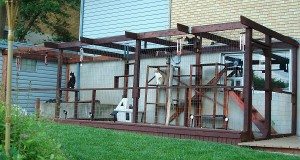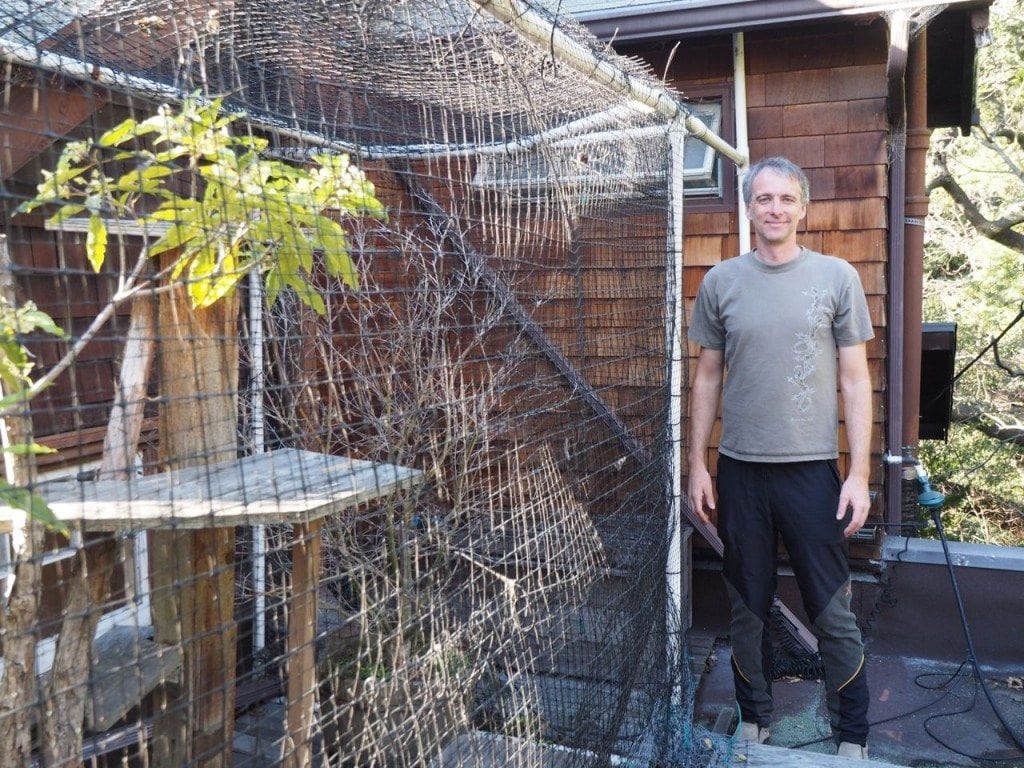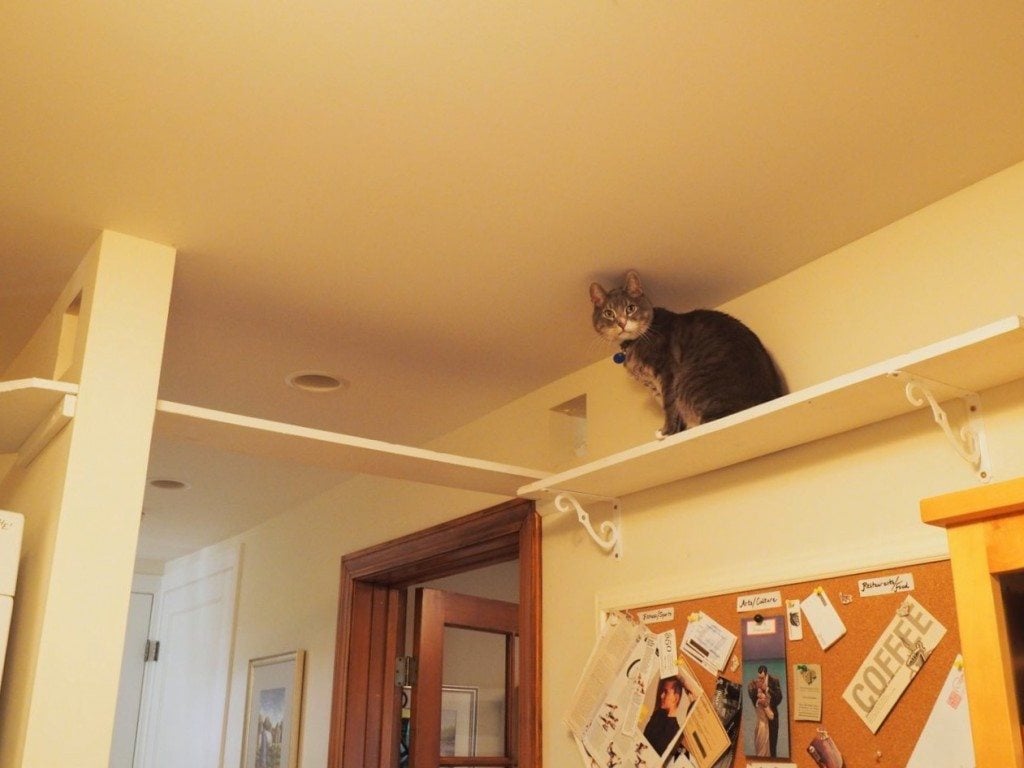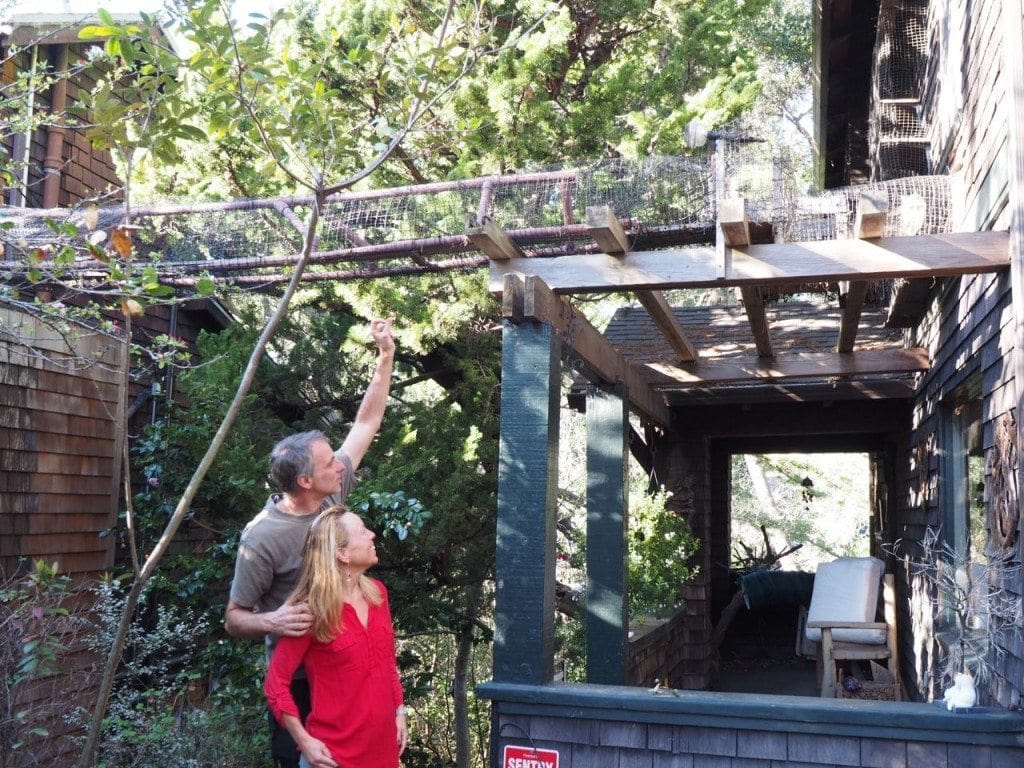Protecting birds and cats with a “catio”
By Ilana DeBare
The black cat named Totoro trained his bright yellow eyes on a Chestnut-backed Chickadee singing on a branch. The chickadee was only a few feet away. There was no windowpane between them. The cat could practically reach out and grab the bird.
The bird was safe.
Totoro was in his “catio” – an outdoor enclosure or patio designed to let house cats experience the sights and smells of the outdoor world, while keeping both birds and the cats themselves from harm.
“We have some of the happiest cats,” said Phil Price, a Golden Gate Bird Alliance board member who built the North Berkeley catio where Totoro was sitting. “They love to come out, sniff the air, sleep in the sun, and watch people walking their dogs down the street.”
The tern “catio” is so new that there’s no Wikipedia entry for it yet. It’s not listed in the Merriam-Webster dictionary.

But the concept is catching on among cat owners who care about birds. Last fall, the Audubon Society of Portland sponsored its first Catio Tour, featuring twelve catios in the Portland, Oregon, area.
The latest scientific studies suggest that outdoor cats – both domestic and feral – kill more than 1 billion birds each year. A single domestic cat typically kills between one and 34 birds each year; one feral cat kills an estimated 23 to 46 birds annually.
Keeping cats indoors is the best way to stop them from killing birds. Keeping cats indoors also helps them stay healthy — safe from hazards like cars, dogs, and fights with other cats.
Catios, meanwhile, are a way to give indoor cats a taste of the outdoors.
Catios can be jaw-droppingly expensive and elaborate. Web sites like CatioShowcase.com feature some cat enclosures that could be mistaken for Hawaiian resorts.


But catios can also be inexpensive and homemade. That’s the case with Phil Price and Juliet Lamont’s Berkeley cat complex.
Price started out in the late 1990s by building a cage out of plastic PVC pipe and wire mesh on the roof of his garage, accessible through a cat door that he cut in a wall. He installed some potted plants and a cat climbing structure.
Then in 2003, he added an outdoor catwalk – a long wooden plank framed by PVC pipe and wire that stretches from his garage roof to the home of his sister-in-law next door.


Next he built a cat ladder – a series of climbable shelves on the outside of his house, again enclosed with wire. He built a similar ladder on the outside of his sister-in-law’s house.
(Price and Lamont also have a network of indoor catwalks – long shelves close to the ceiling, with cat-size holes in the walls that allow their cats to slink overhead from room to room.)


Price estimates that it took him one weekend to build the initial enclosure. All told, he’s put in maybe 30 hours of work on the cat structures.
“None of this stuff was hard to do,” he said. “I’m well aware of how eccentric people think this is. But look at dog owners. They spend half an hour walking their dog every day, 365 days a year. I’ve spent just 30 hours on this in 15 years.”
While Price’s catio has a funky do-it-yourself look, it blends smoothly into his leafy, woodsy Berkeley neighborhood. His brown-shingled house backs up onto Codornices Creek, and he’s counted over 50 species of birds in his back yard.
Despite Price’s love of birds, the initial inspiration for the catio wasn’t avian – it was feline.
“One of our cats got cancer and was on chemo with a depressed immune system,” he said. “We didn’t want them getting out and bringing (germs) back…. The cats came first. The birds we got into later. But once we started thinking about our backyard as a wild area for birds, we couldn’t let the cats out anymore.”
These days Price and Lamont have three cats – Chester, Nimitz and Catesby. Totoro and another cat live next door with Lamont’s sister. Sometimes Price opens a gate within the catwalk so the cats can move freely between the two houses. Other times, he keeps the barrier down and the cats meet and meow at each other through the mesh.
Or, like Totoro, they settle down in a spot with a good view of nearby trees and their feathered inhabitants. Price may be on the board of Golden Gate Bird Alliance, but he is not the only bird watcher in the house.
“People say, ‘It’s not natural to keep cats indoors, cats need to roam,’ ” Price said. “Well, there’s nothing natural about having 30,000 cat-sized predators roaming and hunting in a ten-square-mile urban area… And we have happy cats. They’re engaged, energetic, not neurotic. They play with each other and with us a lot.”


—————————————–
Do you have a catio in the Bay Area? Tell us about it! Post a comment here or email Ilana at idebare@goldengatebirdalliance.org
